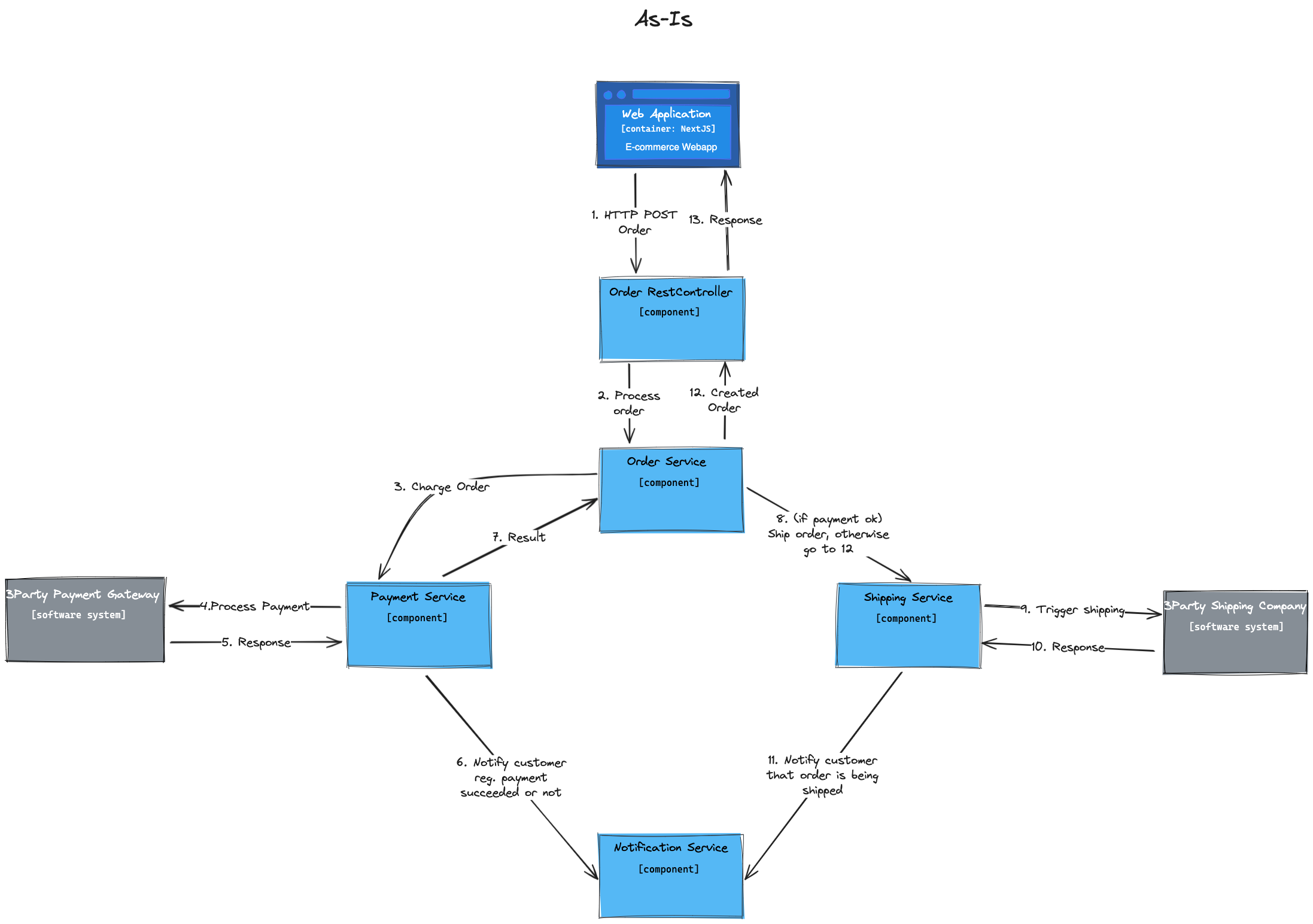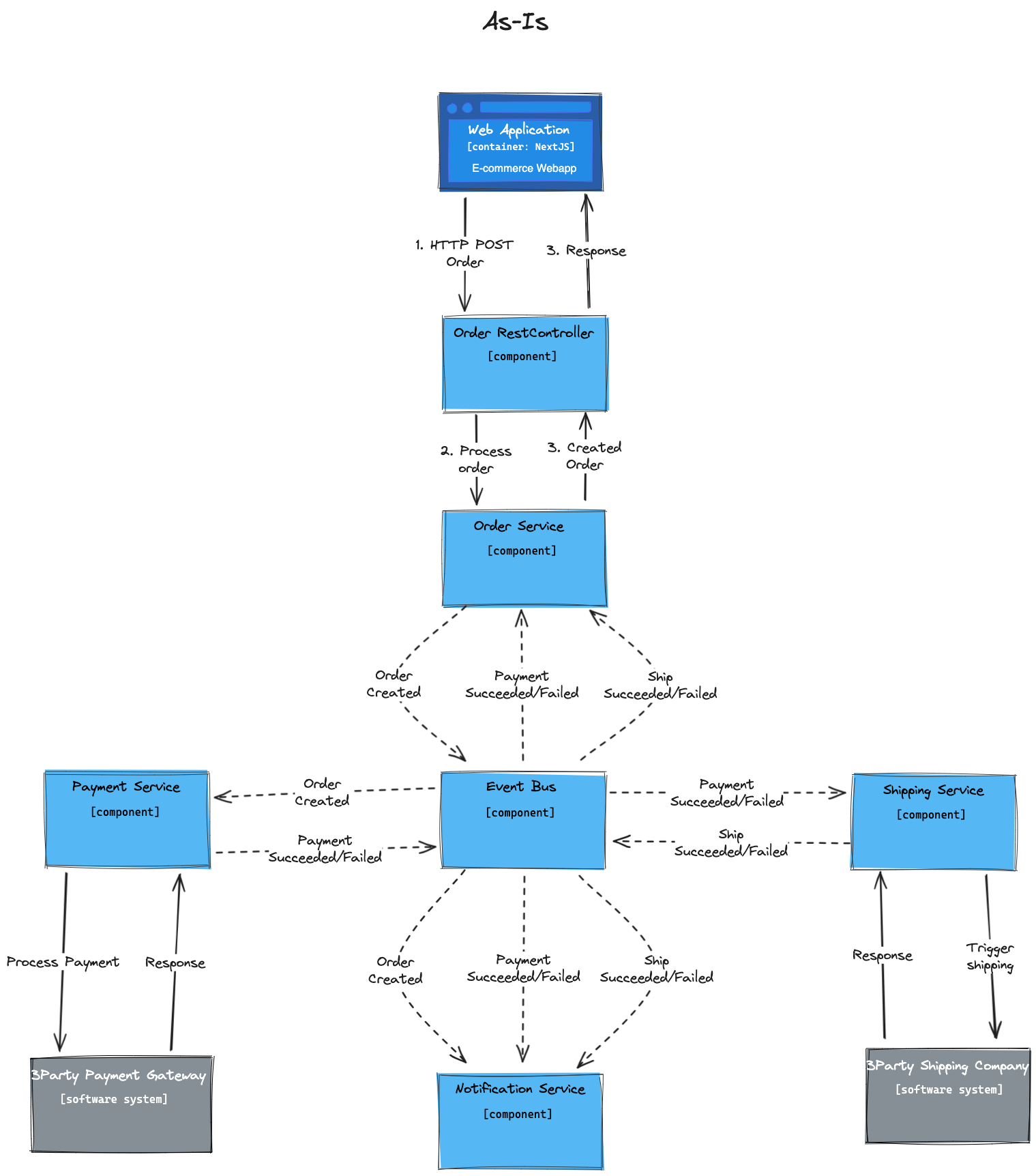This post is part of a series that already has:
- E-commerce Backend - Monolith - Overall Architecture - (Part 1)
- E-commerce Backend - Monolith - Starting with Quarkus - (Part 2)
- E-commerce Backend - Monolith - Caching with Redis - (Part 3)
- E-commerce Backend - Monolith - Docker Compose to run the App and Infra locally - (Part 5)
- E-commerce Backend - Monolith - Local Kubernetes with Kind - to run the App and Infra - (Part 6)
- E-commerce Backend - Monolith - Kubernetes Probes - (Part 7)
This post is about decoupling components by leveraging Quarkus (Verte.x, actually) EventBus. It works in a very similar way as the Spring Events
Introduction
To process an Order, there are several services involved:
- Order service to validate and persist the order;
- Payment service to process the order payment;
- Shipment service to trigger the shipping process;
- Notification service to notify the customer about the success or failure of processing his payment and shipping his ordered products.
So far, the process looks like this:

Here's what it looks like in the code:
// Order Service
...
public Order requestOrder(CreateOrderDTO orderDto) { // 2
Log.tracef("Creating a new order: %s", orderDto);
Order order = mapToOrder(orderDto);
Order createdOrder = create(order);
boolean paymentSucceeded = paymentService.chargeOrder(createdOrder); // 3
if (paymentSucceeded) {
shippingService.shipOrder(createdOrder); // 8
}
// Had to get it from the database to get the updated status that might change during the
// payment and shipping process
return Order.findById(createdOrder.getId()); // 12
}
...
// Payment Service
...
@Transactional
public boolean chargeOrder(Order order) { // 3
Payment payment = new Payment(order.getPaymentAmount(), order);
Log.debugf("Charging payment: %s", payment);
var response = paymentGatewayService.charge(payment); // 4 and 5
if (!response.get("status").equals("201")) {
Log.errorf("Payment failed: %s", response);
notificationService
.notifyByEmail("Your payment for order " + order.getId() + " failed");
orderRepository.updateOrderStatus(order.getId(), OrderStatus.PAYMENT_FAILED);
return false; // 7
}
paymentRepository.savePayment(payment);
notificationService.notifyByEmail("Your payment for order " + order.getId() + " succeeded"); // 6
orderRepository.updateOrderStatus(order.getId(), OrderStatus.PAID);
return true; // 7
}
...
// Shipping Service ... @Transactional public void shipOrder(Order order) { Log.debugf("Shipping order: %s", order); var response = shippingGatewayService.ship(order); if (!response.get("status").equals("201")) { Log.errorf("Shipping request failed: %s", response); orderRepository.updateOrderStatus(order.getId(), OrderStatus.SHIPPING_FAILED); return; } notificationService.notifyByEmail("Your order " + order.getId() + " has been shipped"); orderRepository.updateOrderStatus(order.getId(), OrderStatus.SHIPPED); } ...
// Notification Service ... public void notifyByEmail(String message) { Log.infof("Sending email notification: %s", message); } ...
Note how everything works sequentially and synchronously. Also, those 4 services are tightly coupled as you can notice in the code snippets below.
The problem to be solved
Now I want to tackle the following issues in my code:
- Services are too coupled;
- Some executions don't have to be synchronous as in:
- Calling Notification Services: It is blocking the HTTP request and I don't want to wait until the notification is sent to return the Request Response to the client.
- Triggering Shipment: I also don't care about the Shipping Service response. I want to fire and forget about it. If it fails, I will rely on notifications, and logs and let the Operations team of the E-commerce store resolve any problems with that.
- Because the whole execution flow of Ordering is synchronous and sequential, the average response time of the endpoint is 450ms running locally! That's not good;
- Single Responsibility is being harmed because:
- Payment Service takes care of updating the Order Status if payment succeeds or fails. Order Service should be responsible for updating the order status;
- Same thing for Shipping Service.
Solving those problems
My first thought was to implement the Observer design pattern. But it could be a bit messy because I would have several components acting both as publishers and subscribers:
- The Order Service publishes order created event
- The Payment Service listens to the order created event, then publishes order payment succeeded event
- The Order Service listens to the order payment succeeded event and updates the Order Status to PAID
- The Notification Service listens to the order payment succeeded event and notifies the Customer
- The Shipment Service listens to the order payment succeeded event, triggers the order shipment, and then publishes the order shipped event
- The Notification Service listens to the order shipped event and notifies the Customer
- The Order Service listens to the order shipped event and updates the Order Status to SHIPPED
Then I realized I needed an Event Bus to centralize the events. Fortunately, the Quarkus Vert.x extension provides us with the Verte.x Event Bus. Here is how to use it. It makes much more sense to a component as a broker of events (the Event Bus).
It's important to note that this Event Bus is on the Application level. It's not an external server allowing communication between different applications/services.
Implementation
First thing, as I mentioned before, the Event Bus used in Quarkus comes from Vert.x, so we need to add Vert.x extension to the project:
<dependency> <groupId>io.quarkus</groupId> <artifactId>quarkus-vertx</artifactId> </dependency>
Then we inject the EventBus, remove the calls to PaymentService and ShippingService, and publish an event. We also listen (consume) payment and shipping events to update the Order status accordingly.
// Order Service
@Inject
private EventBus eventBus;
...
public Order requestOrder(CreateOrderDTO orderDto) {
Log.tracef("Creating a new order: %s", orderDto);
Order order = mapToOrder(orderDto);
Order createdOrder = create(order);
eventBus.publish("order.created", createdOrder.id);
return createdOrder;
}
@ConsumeEvent("order.payment.succeeded")
@Blocking
@Transactional
public void onOrderPaymentSucceeded(Long orderId) {
Log.infof("Listening to order payment succeeded: %s", orderId);
orderRepository.updateOrderStatus(orderId, OrderStatus.PAID);
}
@ConsumeEvent("order.payment.failed")
@Blocking
@Transactional
public void onOrderPaymentFailed(Long orderId) {
Log.infof("Listening to order payment failed: %s", orderId);
orderRepository.updateOrderStatus(orderId, OrderStatus.PAYMENT_FAILED);
}
@ConsumeEvent("order.shipping.succeeded")
@Blocking
@Transactional
public void onOrderShippingRequestSucceeded(Long orderId) {
Log.infof("Listening to order shipping succeeded: %s", orderId);
orderRepository.updateOrderStatus(orderId, OrderStatus.SHIPPED);
}
@ConsumeEvent("order.shipping.failed")
@Blocking
@Transactional
public void onOrderShippingRequestFailed(Long orderId) {
Log.infof("Listening to order shipping failed: %s", orderId);
orderRepository.updateOrderStatus(orderId, OrderStatus.SHIPPING_FAILED);
}
...
I think that's enough regarding showing the code. I covered both publishing and consuming events. But if you want to check all the changes to the code, here is the commit doing that: https://github.com/viniciusvasti/practicing-quarkus-ecommerce/commit/0a5191d7ed8eae6a403815fa94ad74280f2a7274
Ah! Now the average response time is under 50ms. Most of the time ~20ms. ~10 to 20x faster =)
The diagram of the Order request now looks like this:

And that's it for this post. Thanks for reading.
